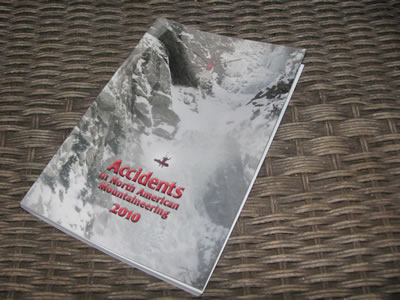| 279 | Accidents 2010 | 2010-09-10 |

The American Alpine Club's "Accidents in North American Mountaineering, 2010" was recently published. Each year we read the booklet in an attempt to learn from the mistakes of others. (Note - the accident reports are for the year 2009, even though it is titled 2010.) In the 2010 issue there was one accident-causing mistake which kept repeating throughout the book. This one mistake caused at least nine different accidents.
- page 47 - Yosemite Valley, California - The belayer was lowering the climber when suddenly the rope passed through the belay device. The climber had a back injury and wore a back brace for three months.
- page 53 - Ouray Ice Park, Colorado - The climber rappelled off the end of the rope. He only suffered a broken ankle and wrist.
- page 53 - Clear Creek Canyon, Colorado - The climber was being lowered when the rope went through the belayer's device. The climber had a concussion.
- page 60 - Boulder Canyon, Colorado - The rope-end ran through the belay device causing the fall. The climber sustained injuries to her face, head, and right knee.
- page 62 - Clear Creek Canyon, Colorado - The climber was being lowered after having led the route, draws still in place. Suddenly he (the climber) was free falling. The climber was lowered off the end of the rope. He sustained back, pelvis, and hip inuries.
- page 63 - Editor's Note - A climber died in Boulder Canyon probably caused by the end of the rope running through the belay device.
- page 73 - Los Alamos, New Mexico - The author rapped off the end of the rope. He had a sprained ankle and other minor injuries.
- page 76 - Shawangunks, New York - A man rappelled off the one end of his rope - as his doubled rope was not even. The man had a fracture of two lumbar vertebrae.
- page 81 - Pine Creek Canyon, Utah - The climber was being lowered - the end of the rope went through the Grigri (belay device). He fractured 3 vertebrae and lacerated his spleen.
Each one of these accidents could have been prevented by tying a simple stopper knot.
When you set up a rappel, always tie a knot in the end of the rope. If you are rappelling on double ropes, tie the ends together. A figure eight or an overhand knot will work as a stopper. These simple knots will prevent you from rappelling off the end of a rope that is too short or double ropes with one strand shorter than the other.
When belaying, always tie a knot in the end of the rope. Either tie a figure eight or overhand knot in the end of the rope (to work as a stopper knot) or the belayer should tie into the end of the rope. the climber should check the belay before leaving the ground.
The simple stopper knot stops accidents like these from happening. Also it should be noted that the belayer seemed to be the one at fault in these incidents; but the lead climber probably had more experience than the belayer and probably readied the rope for climbing.
Let us learn from the mistakes of others, always tie a stopper knot.
Happy "no accidents in 2010" trails.
Click and buy - help support the site!